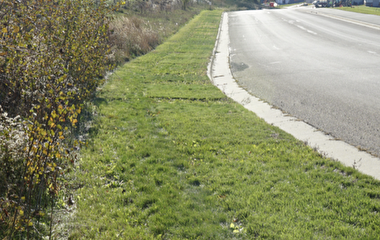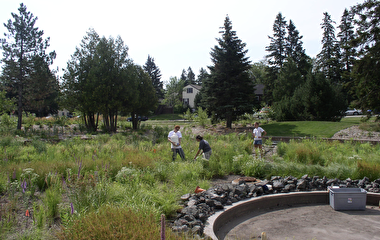Roughly one quarter of bumble bee species are in decline, including the endangered rusty-patched bumble bee. Roadsides offer a unique opportunity to increase habitat for these declining species, which are important pollinators for both crops and natural systems. In a recent study, U of M researchers assessed the bumble bee community and habitat within Twin Cities roadsides and made recommendations for best management practices.
“Overall, we found that roadsides harbor many bumble bee species, including several of conservation concern,” says Dan Cariveau, professor of entomology and the study’s principal investigator. Others on the research team included co-investigator Elaine Evans (assistant Extension professor, entomology) and doctoral candidate Michelle Boone.
The rusty-patched bumble bee—named Minnesota’s state bee earlier this year—is no longer found in more than 95 percent of its original range and was listed as a federally endangered species in 2017. The Twin Cities metro area is one of the few in which this species persists, though in highly reduced numbers, Cariveau says.
In the MnDOT-funded study, researchers surveyed 94 sites along major roads and highways in seven metro counties. Each site was sampled 3 to 15 times (average of 6) throughout the 2018 season. The team recorded 12 species or species groups representing 52 percent of Minnesota bumble bee species. The abundance of blooming flowers at sites varied, with most sites having either low or moderate levels.
The team then used occupancy modeling to estimate the probability of detecting the rusty-patched bumble bee and other bumble bee species at the sites, and in turn, to estimate the “true occupancy” for a species. “This allowed us to determine how many surveys must be performed to be reasonably certain that the rusty-patched bumble bee is absent,” Cariveau says.
The modeling predicted that rusty-patched bumble bees occupy 4 percent of sites, with a 30 percent chance of detection. The researchers recommend performing nine surveys during the main bumble bee activity period to be 95 percent sure that bees are detected if they are there.
The team also examined the relationship of the bumble bee community to surrounding landscape factors. They found that sites with more wooded areas within two kilometers and with greater average floral area had increased bumble bee abundances (total number of all bumble bees recorded) and more bumble bee species. Developed areas also had higher abundances. “Crops, however—primarily corn and soybeans—had a negative impact on abundances and species, including uncommon species,” Cariveau says.
The researchers’ recommendations include adding bumble bee forage to roadsides. “Flowers support both the abundance and species richness of bumble bees,” he says. In addition, the team advises replacing noxious weeds such as Canada thistle and spotted knapweed with floral forage preferred by bumble bees. (Some roadside management plans require the removal of the flowering noxious weeds.) Plants preferred by the rusty-patched bumble bee can be added where its support is a priority.
The study’s findings can help inform decisions for habitat enhancements. “For example, if the goal is to expand the current rusty-patched bumble bee range into areas that the species historically occupied, then increasing floral availability near wooded areas where the surrounding landscape is dominated by crops could help,” Cariveau says.
“It was important to fund this research on Minnesota roadsides while we still have bees to study,” says Christopher Smith, wildlife ecologist and protected species program coordinator with MnDOT’s Office of Environmental Stewardship. “These results will help inform future surveys and provide baseline data needed to evaluate roadside vegetation management practices.”



